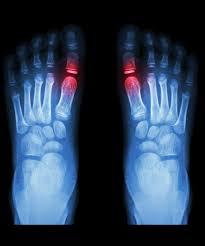Sesamoiditis – From Ballet to Football

What are your ‘sesamoids’?
Your sesamoid bones are two tiny pea-shaped bones in the ball of your foot, beneath your big toe joint (your metatarso-phalangeal joint – or MTP joint). The sesamoid bones are actually embedded within a tendon.
Although tiny, your sesamoids perform a couple of important jobs:
• They act as a pulley for your tendons, helping the big toe move normally and providing leverage when the big toe “pushes off” when you are walking or running.
• They also serve as a weight-bearing surface for the first metatarsal bone (the long bone connected to your big toe), absorbing some of the weight placed on the ball of the foot when walking, running, and jumping.
As the sesamoid’s job involves absorbing weight, it can be at risk of injury when you are doing activity that involves you going up onto your forefoot a lot. Michelle Champlin, Chief Podiatrist at Dubai Podiatry Centre says, “We see sesamoid related injury in dancers, basketball players, footballers, tennis players, golfers and runners. I’ve also seen it in some of our martial arts experts and boxers.”
Other than sport related injuries, we also frequently see sesamoid problems in those with an underlying biomechanical issue – typically supination or pes cavus (very high arches).
Another common source of sesamoid pain and injury is due to footwear, particularly stilettoes, which can force up to 90% of your bodyweight forward onto the forefoot, when during normal stance the weight is distributed nearly equally across your rear and forefoot.
Sesamoid Injuries: Three Types
Mrs. Champlin classifies typical sesamoid related injuries into three main types:
• Sesamoiditis is a chronic overuse related injury causing the sesamoid bones and surrounding tendons to be come inflamed and painful. Generally we see this in overuse of high heels or sports players. You will feel a chronic, ongoing pain in your forefoot behind your big toe joint that might come and go. It will feel worse when you put weight on the area when wearing high heels again or doing an activity with weight onto your forefoot, such as at the end of your golf swing.
• Sesamoid Fracture may be acute (instant, due to a trauma or accident) or chronic due to ongoing stress to the forefoot / sesamoids – e.g. through sports or high heels. You will feel intense pain at the time of an acute fracture, or ongoing intermittent dull pain with a stress fracture, relieved by resting.
• Turf Toe is an injury caused by ‘overextending’ the big toe joint past its normal range of motion. You may hear a ‘pop’ at the time and you will feel immediate pain. The big toe joint will then have limited range of motion when you try to move it. It’s called turf toe as it tends to happen to athletes on an artificial or even a real grass surface, with risk of catching your toe in football cleats, but we have also seen it in gymnasts, wrestlers, golfers and more.
What will the Podiatrist Do?
Sesamoid injuries can involve the bones, tendons, and/or surrounding tissue in the joint. We examine you thoroughly with a lower limb biomechanical assessment, which will include pressing on the big toe, moving it up and down to check range of motion, palpating the toe and foot, checking how you stand (weight bearing posture) and walk as well as how your feet are when non weight bearing. We will also find out from you how and when the pain started or goes away, check your footwear and discuss your physical activity and sports.
How are sesamoid injuries treated?
• Special padding or strapping to the foot
• Pain alleviating anti-inflammatory oral medication
• Custom orthotic therapy to correct any underlying biomechanical cause / redistribute weight off of the sesamoids / MTP joint
• Immobilization in an aircast
• Strengthening exercises, particularly after aircast therapy.
If you feel either an acute or dull, throbbing pain to your forefoot or bog toe joint, it is best to make an appointment to see the foot experts at Dubai Podiatry Centre. We can correctly identify the cause, diagnose and provide treatment to get you back en pointe, teeing off, or at the starting line in record time.
For appointment, contact us:
Call: + 971 4 3435390
WhatsApp: + 971 50 355 3024
info@dubaipodiatry.com
To book online: Click here








2 comments
Edward Eugen
September 17, 2018 at 2:24 am
This is the article which I was looking for, this is going to help me out with my confusion really well. Nice piece of Information. Your blog is an awesome platform for the people who want the best info about sesamoiditis. Thanks and very well written.
Dubai Podiatry Centre
September 24, 2018 at 1:47 pm
Dear Edward, Thank you for your kind words and we are all glad to hear it was useful information about the foot and sesamoiditis, Best wishes, Dubai Podiatry Centre